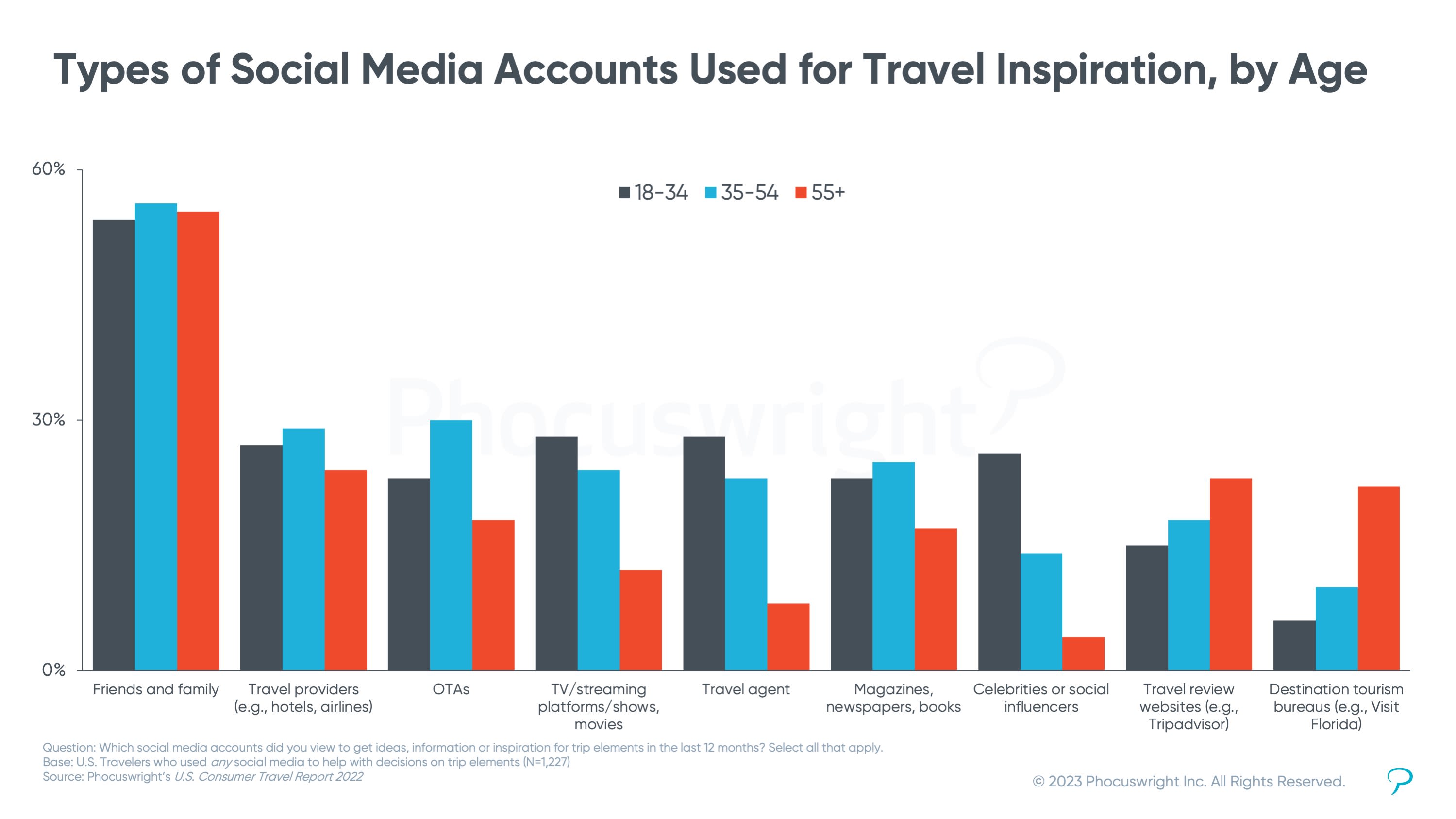Under the influence: Social media's role in trip planning
A preview of Phocuswright's research report Under the Influence: Social Media's Role in Trip Planning and Inspiration

Travel is alive and buzzing in the ecosystem of social media. Users, brands and influencers alike are piping in across platforms to share, guide and inspire across all touchpoints of the trip experience. But while the conversation is vibrant, the social media sphere is continuously transforming, and travelers on social platforms often diverge from some of the patterns observed when people engage with content associated with other industries, such as fashion or retail.
This is a preview of Phocuswright's latest travel research report Under the Influence: Social Media's Role in Trip Planning and Inspiration, which is derived from the findings of Phocuswright’s U.S. Consumer Travel 2022 survey and explores the demographics of who is using social for travel, what platforms they’re on, and the role of social in their travel practices. With a plethora of travel users, providers, distributors and influencers at the table, Phocuswright’s primary travel research highlights opportunities to optimize social strategy to better speak to the needs, habits and budgets of travelers on social.
Social’s role in trip planning

With its visual formats and personal touches, social media content plays a significant role as travelers figure out where to go and what to do on their trips. More than half of all leisure travelers used a social media platform to aid at least some of their trip-related decisions. Travelers who are younger than 35 are particularly likely to use social media, with 81% saying they used it, compared to only 14% of those 55 and older.
While social can be helpful in passive information collection, it is not typically the go-to for the active research process, where general search emerges as a prominent resource. For resources that were very or extremely influential when they were choosing a destination for their most recent trip, general search out performed social media.
Social remains influential in destination selection but exists among a large set of sources that travelers consult in the decision-making phase.


Based on demographic usage, there were some indications that general search use could decline over time. As Gen Z becomes a more prominent demographic in the U.S. traveling population, this group’s propensity to rely on social media may lead to increased reliance on social networks in the active research process.
With conversational AI rapidly entering the mainstream, general search will evolve rapidly to accommodate these new developments. Microsoft’s Bing search engine has already introduced AI-powered chat functionality. Online travel agencies (OTAs) like Trip.com and Expedia have added plug-ins and/or incorporated conversational AI into their own apps in a bid to reduce friction during travel planning and booking.
Under the influence

Conversations on social and influencer marketing go hand in hand. Influencers have become a fixture of the modern social media presence, and partnering brands latch onto them for access to their followers and content expertise. The fashion industry in particular has enjoyed remarkable success from their work with influencers; leading platform LTK yields $3.6 billion in annual sales in the fashion space.
But travel marketing is a horse of a different color, and there are essential distinctions to draw between the way consumers engage and convert with travel content compared with influencer content pertaining to other industries. Across all traveler age groups, the most common types of accounts used for inspiration – by a significant margin – come from family and friends (55%) (see figure below). Travelers turn to personal contacts who they know and trust for direction, inspiration or advice.


But beyond the social accounts of family and friends, travelers are more likely to reference a string of other account types before they turn to celebrities or influencers. Travel providers, OTAs, agents, TV and print media accounts are all referenced at a higher frequency than those of celebrities or social influencers, which are only utilized by 18% of travelers on social.
Though they are not the most commonly used by any stretch, celebrity or influencer accounts can be valuable in their reach. Influencers capture the attention of followers who express an avid interest in their travel and content styles, and who often look to them as advisers and tastemakers.
While brands and marketers may choose to partner with content creators in part to push the aspirational or inspirational elements of travel, companies should also consider how their offerings fit with influencers’ social personas and the profile of their follower base. Many of those who engage with travel social content cannot make luxury travel purchases, but could be inclined toward other mid-tier or budget offers that more closely match their habits and budgets.


WEEKLY RESEARCH INSIGHTS
We dig deep to give you the data and trends that drive the travel, tourism and hospitality industry.
Get the latest in travel industry highlights with our free weekly research articles and more. Sign up to get the latest delivered directly to your inbox.
FOR MORE INSIGHTS
See all of Phocuswright's free research insights here.
Sign up to get the latest delivered directly to your inbox.
Open Access Research Subscription

Research is our priority. Our Open Access research subscription puts the world’s most comprehensive library of travel research and data visualization at your fingertips.
Clients have relied on Phocuswright's deep industry knowledge for over 25 years to power great decisions, help justify a pitch, build a strategic plan and elevate any presentation through trusted research and data. When companies and executives reference Phocuswright, they gain the trust of an industry keen on data, trends and analytics.
See the full benefits of an Open Access subscription here.

